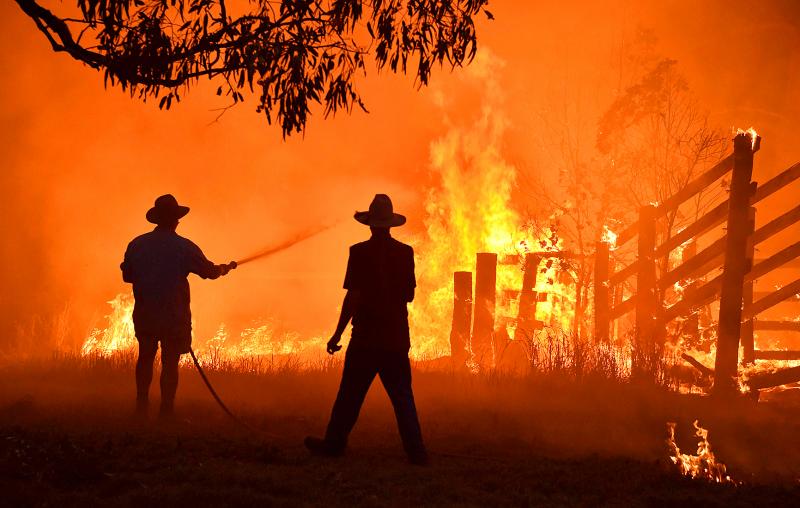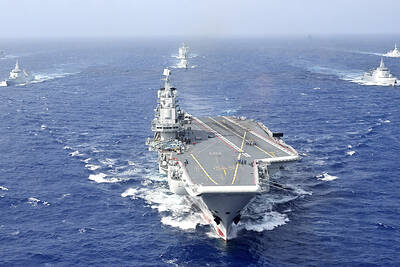Australians should be ready for “compounding” overlapping crises as they face more frequent, costly and severe climate-change-worsened disasters, an inquiry into the nation’s recent historic bushfires said yesterday.
Following devastating blazes over the past two years that killed 33 people and burned an area the size of the UK or Ghana, a Royal Commission told Australians “what was unprecedented is now our future.”
Predicting a future in which disasters “will regrettably be more frequent and more severe,” the commission said: “We can also expect more concurrent and consecutive hazard events.”

Photo: AFP
“In the last 12 months, there was drought, heatwaves and bushfires, followed by severe storms, flooding and a pandemic,” it added.
By the time that the bushfires had ended in March, they had killed or displaced nearly 3 billion animals and cost the economy an estimated US$7 billion.
However, the commission said that the annual cost of disasters is likely to rise to about US$27 billion by 2050, even before accounting for worsening global warming.
The report, which focused heavily on the effects of climate change in producing more extreme weather, said: “Further global warming over the next two decades is inevitable.”
“As a result, sea levels are projected to continue to rise,” it added. “Tropical cyclones are projected to decrease in number, but increase in intensity. Floods and bushfires are expected to become more frequent and intense.”
The report called for better data and more granular projections about what climate change means for specific areas.
However, it stopped short of calling on the conservative government — which has slow-pedaled countermeasures — to address the underlying causes.

A Chinese aircraft carrier group entered Japan’s economic waters over the weekend, before exiting to conduct drills involving fighter jets, the Japanese Ministry of Defense said yesterday. The Liaoning aircraft carrier, two missile destroyers and one fast combat supply ship sailed about 300km southwest of Japan’s easternmost island of Minamitori on Saturday, a ministry statement said. It was the first time a Chinese aircraft carrier had entered that part of Japan’s exclusive economic zone (EEZ), a ministry spokesman said. “We think the Chinese military is trying to improve its operational capability and ability to conduct operations in distant areas,” the spokesman said. China’s growing

Nine retired generals from Taiwan, Japan and the US have been invited to participate in a tabletop exercise hosted by the Taipei School of Economics and Political Science Foundation tomorrow and Wednesday that simulates a potential Chinese invasion of Taiwan in 2030, the foundation said yesterday. The five retired Taiwanese generals would include retired admiral Lee Hsi-min (李喜明), joined by retired US Navy admiral Michael Mullen and former chief of staff of the Japan Self-Defense Forces general Shigeru Iwasaki, it said. The simulation aims to offer strategic insights into regional security and peace in the Taiwan Strait, it added. Foundation chair Huang Huang-hsiung

PUBLIC WARNING: The two students had been tricked into going to Hong Kong for a ‘high-paying’ job, which sent them to a scam center in Cambodia Police warned the public not to trust job advertisements touting high pay abroad following the return of two college students over the weekend who had been trafficked and forced to work at a cyberscam center in Cambodia. The two victims, surnamed Lee (李), 18, and Lin (林), 19, were interviewed by police after landing in Taiwan on Saturday. Taichung’s Chingshui Police Precinct said in a statement yesterday that the two students are good friends, and Lin had suspended her studies after seeing the ad promising good pay to work in Hong Kong. Lee’s grandfather on Thursday reported to police that Lee had sent

BUILDUP: US General Dan Caine said Chinese military maneuvers are not routine exercises, but instead are ‘rehearsals for a forced unification’ with Taiwan China poses an increasingly aggressive threat to the US and deterring Beijing is the Pentagon’s top regional priority amid its rapid military buildup and invasion drills near Taiwan, US Secretary of Defense Pete Hegseth said on Tuesday. “Our pacing threat is communist China,” Hegseth told the US House of Representatives Appropriations Subcommittee on Defense during an oversight hearing with US General Dan Caine, chairman of the Joint Chiefs of Staff. “Beijing is preparing for war in the Indo-Pacific as part of its broader strategy to dominate that region and then the world,” Hegseth said, adding that if it succeeds, it could derail